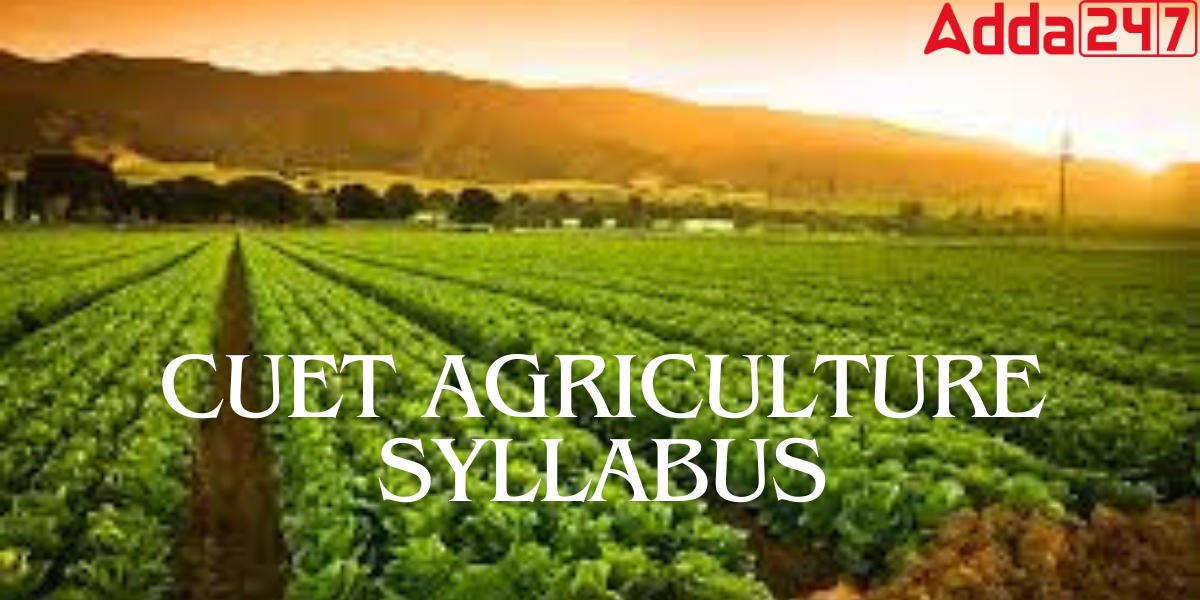CUET Agriculture Syllabus 2026: The National Testing Agency provides the CUET Agriculture Syllabus for the Common University Entrance Test 2025 for Undergraduates. Candidates can access and download the CUET Syllabus for Agriculture from the CUET official website. On this website, you can also get the CUET Agriculture Syllabus PDF. The CUET UG agricultural syllabus defines and describes each unit that will be studied in the exam. The NTA has amended the CUET UG exam pattern, which includes the Agriculture Question Paper 2026. For a better understanding, we have shared the CUET 2026 Agriculture Syllabus PDF & exam pattern in detail on this page.
CUET Agriculture Syllabus 2026
The CUET UG Agriculture Exam is expected to take place between May and June 2026. Understanding the CUET Agriculture Syllabus 2026 is the foundation for candidates who plan to pursue their higher studies in Agriculture. Along with the General CUET Syllabus. CUET aspirants in the Agriculture domain must go through the CUET Syllabus for Agriculture in detail before starting CUET preparation in the full phase.
CUET Agriculture Syllabus
The Common University Entrance Test (CUET 2026) is held for students seeking admission to Central Universities for undergraduate programs. The CUET Exam is divided into three sections. Section I is for Languages subject, Section II – 23 Domain-specific Subjects, and Section III – General Aptitude Test (earlier known as General Test paper).
Section II of the CUET includes tests on all the domain-specific subjects. Section II includes the Agriculture domain. Agriculture question papers: 50 compulsory questions of the objective type, calculating a total score of 250 marks. To achieve the highest mark and get a seat at a dream college, you need to study hard and master the topics included in the syllabus.
CUET Agriculture Exam Pattern 2026
The table below gives all the important details about the CUET Agriculture exam syllabus and its exam pattern. Students can go through it to understand what topics they need to study and how the exam will be structured. This will help them prepare better and score well in the exam. From the number of questions to the marking scheme, everything is clearly mentioned for easy understanding. Make sure to check the table and plan your preparation accordingly.
| CUET Agriculture Syllabus 2026-27: Overview | |
| Exam-conducting body | National Testing Agency |
| Examination Name | Common Universities Entrance Test (CUET) |
| Medium of Examination | 13 Languages (English, Kannada, Hindi, Punjabi, Marathi, Tamil, Urdu, Malayalam Odia, Assamese Telugu, Bengali, and Gujarati ) |
| Examination Mode | Computer-based Test (CBT) |
| Time Allotted for Agriculture Exam | 60 minutes |
| Total number of questions in the Agriculture section |
50 questions |
| Total Agriculture Questions to be Answered | 50 questions |
| Total Marks in Agriculture Section | 250 Marks |
| Marking Scheme | Marks per correct answer: +5 Marks per wrong answer: -1 Marks per unanswered questions: 0 |
CUET Previous Year Question Paper
CUET UG Agriculture Syllabus Unit Wise
The entire Agriculture Syllabus of CUET is based on NCERT Class XII. The CUET UG Agriculture syllabus is divided into 4 units. The topics included in the CUET UG agriculture syllabus include agrometeorology, genetics and plant breeding, biochemistry, microbiology, raising livestock, growing crops, and horticulture. Now we will discuss all 4 units of the CUET Agriculture Syllabus in a detailed manner below.
CUET UG Agriculture Syllabus- Unit-1
Unit-1: Agrometeorology, Genetics and Plant Breeding, Biochemistry and Microbiology
Agrometeorology: Elements of weather- rainfall, temperature, humidity, wind velocity, Sunshine weather forecasting, climate change in relation to crop production.
Genetics & Plant Breeding :
(a) Cell and its structure, cell division-mitosis and meiosis and their significance
(b) Organisation of the genetic materials in chromosomes, DNA, and RNA
(c) Mendel’s laws of inheritance. Reasons for the success of Mendel in his experiments, Absence of linkage in Mendel’s experiments.
(d) Quantitative inheritance, continuous and discontinuous variation in plants.
(e) Monogenic and polygenic inheritance.
(f) Role of Genetics in Plant breeding, self and cross-pollinated crops, methods of breeding in field crops-introduction, selection, hybridization, mutation and polyploidy, tissue and cell culture.
(g) Plant Biotechnology definition and scope in crop production.
Biochemistry: pH and buffers, Classification and nomenclature of carbohydrates, proteins, lipids, vitamins, and enzymes.
Microbiology: Microbial cell structure, Micro-organisms- Algae, Bacteria, Fungi, Actinomycetes, Protozoa, and Viruses. Role of micro-organisms in respiration, fermentation, and organic matter decomposition
CUET Agriculture Syllabus 2025: Unit-2
Unit-2: Livestock Production
Scope and importance :
(a) Importance of livestock in agriculture and industry, White revolution in India.
(b)Important breeds Indian and exotic, distribution of cows, buffaloes and poultry in India.
Care and management :
(a) Systems of cattle and poultry housing
(b) Principles of feeding, feeding practices
(c)Balanced ration definition and ingredients.
(d) Management of calves, bullocks, pregnant and milch animals as well as chicks cockerels and layers, and poultry.
(e) Signs of sick animals, symptoms of common diseases in cattle and poultry, Rinderpest, black quarter, foot and mouth, mastitis and hemorrhagic septicemia coccidiosis, Fowl pox and Ranikhet disease, their prevention, and control.
Artificial Insemination: Reproductive organs, collection, dilution and preservation of semen and artificial insemination, role of artificial insemination in cattle improvement. Livestock Products: Processing and marketing of milk and Milk products
CUET UG Agriculture Syllabus: Unit-3
Unit-3: Crop Production
Introduction :
(a) Targets and achievements in foodgrain production in India since independence and its future projections, sustainable crop production, commercialization of agriculture and its scope in India.
(b) Classification of field crops based on their utility-cereals, pulses, oils seeds, fibre, sugar and forage crops.
Soil, Soil fertility, Fertilizers and Manures:
(a) Soil, soil pH, Soil texture, soil structure, soil organisms, soil tilth, soil fertility and soil health. (b) Essential plant nutrients, their functions and deficiency symptoms.
(c) Soil types of India and their characteristics.
(d) Organic manure, common fertilizers including straight, complex, fertilizer mixtures and biofertilizers; integrated nutrient management system.
Irrigation and Drainage:
(a) Sources of irrigation (rain, canals, tanks, rivers, wells, tube-wells).
(b) Scheduling of irrigation based on critical stages of growth, time interval, soil moisture content and weather parameters.
(c) Water requirement of crops.
(d) Methods of irrigation and drainage.
(e) Watershed management
Weed Control: Principles of weed control, methods of weed control (cultural, mechanical, chemical, biological, and Integrated weed management).
Crops: Seedbed preparation, seed treatment, time and method of sowing/planting, seed rate; dose, method, and time of fertilizer application, irrigation, intercultural and weed control; common pests and diseases, caused by bacteria, fungi viruses, and nematode and their control, integrated pest management, harvesting, threshing, post-harvest technology: storage, processing, and marketing of major field crops-Rice, wheat, maize, sorghum, pearl millet, groundnut, mustard, pigeon-pea, gram, sugarcane, cotton, and berseem.
CUET UG Agriculture Syllabus: Unit-4
Unit-4: Horticulture
(a) Importance of fruits and vegetables in the human diet, Crop diversification & processing
Industry.
(b) Orchard- location and layout, ornamental gardening, and kitchen garden.
(c) Planting system, training, pruning, intercropping, protection from frost and sunburn.
(d) Trees, shrubs, climbers, annuals, perennials, and examples. Propagation by seed, cutting, budding, layering, and grafting.
(e) Cultivation practices, processing, and marketing of (i) Fruits – mango, papaya, banana, guava, citrus, grapes. (ii) Vegetables – Radish, carrot, potato, onion, cauliflower, brinjal, tomato, spinach, and cabbage. (iii) Flowers – Gladiolus, canna, chrysanthemums, roses and marigold. (f) Principles and methods of fruit and vegetable preservation. (g) Preparation of jellies, jams, ketchup, chips, and their packing.
CUET Agriculture Syllabus PDF Download
The CUET Agriculture syllabus PDF is available on the official website of the National Testing Agency (NTA). Students who are preparing for the CUET Agriculture 2026 exam can visit the official site and download the syllabus easily. To make it even easier for you, we have also shared the direct link to download the CUET Agriculture syllabus PDF below. This syllabus will help you know what topics to study and how to plan your preparation. Make sure to check it before starting your studies.
Best books for CUET Agriculture Exam 2026
Preparing for the CUET Agriculture syllabus necessitates a thorough knowledge of agricultural units, concepts, and practices. Choosing the appropriate CUET preparation books can help you prepare and have an important impact.
The recommended books for studying for the CUET Agriculture exams are:
- Class 11th & 12th Textbooks by NCERT
- ICAR AIEEA UG Entrance Exam (Agriculture) by Arihant Express/ R. Gupta
- Fundamentals of Agriculture by Arun Katyayan
- A Complete Guide to Agriculture by Bhani Ram Dall, Mamta Dall
- Principles of Agronomy by Yellamanda Reddy and G.H. Peiris
- A Competitive Book of Agriculture by Nem Raj Sunda
- Objective Agriculture by S R Kantwa
- Introduction to Agriculture by Akhtar Hussain and M.A. Bari










 DU CSAS Portal UG 2025 @admission.uod.ac...
DU CSAS Portal UG 2025 @admission.uod.ac...
 CUET Cut Off 2025: DU, BHU, JNU, Jamia Q...
CUET Cut Off 2025: DU, BHU, JNU, Jamia Q...
 How To Prepare for CUET Accountancy Exam...
How To Prepare for CUET Accountancy Exam...


